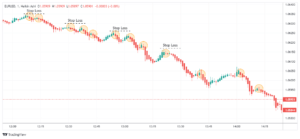Given the continuous concerns over the banking sector crisis, the inflation report next week will once again be in the spotlight. The release of the CPI index for the Eurozone as well as the PCE inflation figures in the United States will dominate the headlines. Australia will also release inflation data, while in Japan, Tokyo prices will be under scrutiny.
Will PCE inflation complicate the path of the Federal Reserve rate?
Given the FOMC meeting and the banking crisis, investors should focus closely on US inflation data. The PCE inflation report, along with personal income and spending data, will be released on Friday. While there has been progress in recent months in reducing overall price pressures, the Federal Reserve has focused its efforts on services inflation, and as such, the latest assessment by Fed Chair Jerome Powell is that there has been no progress in removing housing components.

Policymakers will have the opportunity to take another look at February prices, this time in the form of the PCE price index. The Fed pays more attention to this specific measure of inflation, so any surprise increase could be a condition for a 0.25% increase in the next interest rate hike in May. Consumer confidence index by the Conference Board on Wednesday and personal consumption expenditures on Friday will also be in focus. The consumer confidence index looks more to the future, so any weak release in March could be accompanied by regional bank crises.
The S&P Corelogic Case-Shiller Home Price Index on Wednesday and existing home sales on Thursday will be important factors showing that this sector is improving after last year’s slump. The final estimate of fourth-quarter gross domestic product will be released on Thursday, and the latest Chicago PMI index will be published on Friday.
Given that the market sentiment is still weak after the bank’s bankruptcy, investors are likely to react negatively to strong data as they have less reason to be cautious about the Federal Reserve. However, this may not necessarily increase the value of the US dollar.
It is expected that inflation in the Eurozone will decrease again.
The European Central Bank may have reduced its guidelines in March, but policymakers were eager to signal that there is still a likelihood of further rate hikes in the coming months, as inflation remains well above the 2% target. The preliminary inflation figures for March, which are due to be released on Friday, may show a drop below 8%, but the bigger headache for the ECB is the sustained increase in underlying inflation metrics.
Excluding food, alcohol, and energy, it is predicted that the Consumer Price Index will increase from 5.6% in February to 5.8% in March.
As this trend continues, the likelihood of the European Central Bank remaining on a contractionary path increases, and the prospect of a stronger euro while the Federal Reserve pauses rate hikes. As long as the impact of the banking crisis on the eurozone economy is contained, the euro has a good chance of weathering its recent high of $1.1033 over the past few months.
However, there is a risk of credit tightening in the United States, even if there are no new losses from Silicon Bank’s collapse. Powell has emphasized the risk that credit conditions could tighten regardless of further rate hikes, as banks become more cautious and offer fewer high-risk loans.
Nevertheless, this does not mean that European economies will not feel any negative effects, and investors will be prepared for any loss of business confidence. March surveys on Tuesday for Germany’s IFO business climate index and Eurozone economic sentiment index will follow.
Investors are paying attention to CPI data because there is a possibility of a rate pause.
The Australian central bank has started the discussion on halting the rate hike that was initiated months before the banking crisis, and is likely to have a stronger inclination to do so at their April meeting. Currently, the markets have priced in a 90% probability, and the inflation figures to be released on Thursday could bring these odds closer to 100% if an unexpected decrease occurs.
The central bank of Australia is hopeful that inflation peaked in December when it reached 8.4%, and decreased significantly to 7.4% in February. Another drop in March is seen as a decisive reason for halting the rate hike in April, although this may not be good news for the Australian dollar.
On the other hand, a stronger-than-expected CPI release would be positive for the Australian dollar, and if these indicators continue to show improvement in the economy in March, the manufacturing sector PMI outside of China on Friday could also be positive.
The picture of inflation in Japan is still unclear.
“This week is very important and busy in Japan. The initial statistics for industrial production, retail sales, and unemployment rate for the month of February will be released this week. However, most investors’ interest is likely to be on the release of the CPI index for Tokyo in March.
Japan’s inflation rate sharply declined in February, putting pressure on the Bank of Japan to further reduce its stimulus policies. The March forecast shows that the net CPI in Tokyo may decrease slightly. This, which has recently been increasing against its US counterpart, may try to increase its profits if the predictions are realized.
However, if inflation rises again, it could intensify speculation about a type of policy action by the Bank of Japan at the April meeting, just as after the spring wage negotiations in which labor unions agreed to an inflationary wage deal with an average of 3.8% annually.”












